El Cadejo: The Guardian and the Haunter
Reading Time: 13 min
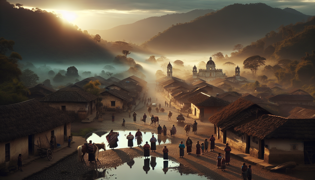
About Story: El Cadejo is a Legend from guatemala set in the Ancient. This Descriptive tale explores themes of Good vs. Evil and is suitable for All Ages. It offers Cultural insights. A dual‑natured canine spirit one dark and menacing, the other white and protective.
Introduction
In the high valleys of Guatemala, where the vibrant hues of market stalls mingle with the echo of ancient traditions, the legend of El Cadejo is whispered on every wind. Under the gentle glow of early morning sunlight and in the quiet moments before the day unfolds, the people recall a time when spirits walked beside them. Cobblestone streets lead to centuries-old churches, their bells resonating through the mist as local children chase each other in playful glee. Yet, as dusk approaches and shadows lengthen, an inexplicable presence lingers – a presence both feared and revered. At the heart of this tale is Diego, a thoughtful young man who has grown up on stories filled with lore and mystery. Raised by his abuela among the gentle murmur of ancient rituals and the haunting sounds of distant drums, he learned early that the line between light and darkness is delicate. In hushed tones over steaming cups of maize-based atole, elders recounted the duality of a canine spirit: one form, as dark as the impenetrable night, a reminder of the hidden fears of the heart; the other, pure as freshly fallen snow, a guardian protecting those in need. Moreno skies give way to amber twilight on festival nights, evoking both the sorrow of loss and the hope of renewal—a timeless reminder that within every fearful shadow, there may dwell a spark of redemption. As Diego reflects on these memories beneath the ancient ceiba tree in the village square, he senses that the old stories are not mere fables, but intricate maps leading to deeper truths about courage, duality, and the eternal dance between good and evil.
The Whispering Shadows
Diego’s earliest memories were woven from the threads of moonlit nights and secretive whispers, where every creaking door and turning corner in his small village told a story. As a boy, he would sit in the dim light of his grandmother’s rustic kitchen, where the aroma of freshly ground maize and rich spices mingled with stories of mystical beings. These tales spoke of El Cadejo—the dual canine spirit that roamed on fog-laden nights. According to legend, one form was shrouded in ashen darkness, its eyes penetrating the soul with an eerie luminescence. This sinister cadre was said to prowl the outskirts of the village, ensnaring those who meandered too close to the unknown. Yet, juxtaposed with this foreboding image was the gentle specter of a luminous white canine, whose presence was a herald of hope and protection. Diego learned that these two faces of a single entity embodied the sacred balance between fear and solace, chaos and comfort.
By day, the village buzzed with life. The sun illuminated vibrant murals on old adobe walls; vendors arranged their colorful produce, and friends exchanged tales of minor miracles. Underneath this familiar cheer, however, the enigmatic energy of the legend pulsed like a secret drumbeat. Diego's solitary walks through orchards and valleys were punctuated by fleeting glimpses of a spectral shape darting away behind lush groves and ancient stone markers. His senses were heightened by both wonder and trepidation. The interplay of warm daylight and fleeting shadows created a natural rhythm, a reminder that every moment could conceal hidden depths. In these moments, even the simplest sounds—a rustle in the wind or the distant cry of a quetzal—became charged with deeper meaning.
At the local chapel, where stained glass windows scattered prismatic light over pews worn by centuries of prayer, Diego found solace in quiet communion. His soul, tender and curious, absorbed the legend like a parched field drinks in the rain. He began to notice a recurring symbol in daily life: the outline of a hound in the carvings of wooden doors, the echo of footsteps that mirrored the cadence of a heartbeat both fierce and kind. Each instance felt like a message from the spirit world—a reminder that the duality was not merely myth, but an enduring part of the tapestry of existence. As twilight approached one fateful evening, the boundaries between reality and fable blurred. In the corridor of time, shadows deepened and something shifted inside Diego. He recognized this as the silent call of the unknown, inviting him to explore the delicate balance between the terror of the dark and the comfort of the light.
In the cool embrace of the night, with soft beams of moonlight leading the way, the legend of El Cadejo took on a visceral life inside his heart. It was a summons to understand that every story, every myth, encased a kernel of truth. In that balance of terrifying darkness and soothing luminescence, Diego detected the enduring pulse of his own inner battle—a struggle between fear and trust, despair and hope.
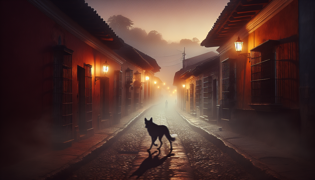
Guardian of Midnight
As years passed, Diego's curiosity evolved into an inner quest. No longer satisfied by the half-spoken lore of childhood, he sought the hidden wisdom within the tale of El Cadejo. One humid summer night, during a local festival drenched in laughter and dancing under strings of paper lanterns, Diego experienced a moment of extraordinary clarity. Amid the vibrant celebrations and the soft murmur of distant guitars, an unexpected chill swept through the crowd. In the layered interplay of festive light and encroaching shadows, a brilliant white canine emerged from the darkness. Its coat glowed with an ethereal light, as if woven from moonbeams and the promise of new beginnings. Eyewitnesses claimed the creature moved with a majestic grace, its eyes shining with a warmth that belied its spectral nature.
The protective aspect of El Cadejo, embodied in the white form, quickly became the subject of Diego’s fascination. Determined to understand its purpose, he began discreetly following the creature at a distance, through alleys draped in twinkling fairy lights and along paths bordered by flowering bougainvillea. With each encounter, he noticed that the white guardian appeared only when danger lurked—a wayward child stepping too near a dangerous crevice, or a weary traveler lost in the labyrinthine lanes of the village. This canine protector operated outside the bounds of conventional explanation. Its arrival coincided with moments of crisis, a beacon that seemed to incarnate compassion and empathy itself.
One chance encounter led Diego into the timeworn ruins outside the village, a forgotten chapel where nature had slowly reclaimed crumbling stone walls. Here, in the interplay of soft moonlight filtering through broken arches, the white Cadejo revealed its true nature. In the delicate moments before midnight, it approached a frightened villager, protecting her from a threatening figure that lurked in the shadows. With each heartbeat, the spectral form radiated an aura of serenity that counteracted the palpable tension of the night. As Diego observed, the creature’s presence transformed the oppressive environment: the decrepit ruins seemed to momentarily burst into life with gentle luminescence and vibrant hues reminiscent of dawn.
Compelled by this act of benevolence, Diego began to record the creature’s appearances using sketches and journal entries. He discovered that this guardian was not simply protecting individuals but was an embodiment of a larger cosmic balance. The white form spoke to him in delicate, unspoken messages—a reminder that even in the darkest corners, there dwells a light determined to preserve life and hope. In a realm where mysticism and reality merged, the protective canine became a metaphor for the human capacity to overcome fear through compassion and understanding. As he left the ruins that night, the memory of the white Cadejo imprinted itself on his heart, urging him to embrace his destiny and the intrinsic duality that he sensed within himself.
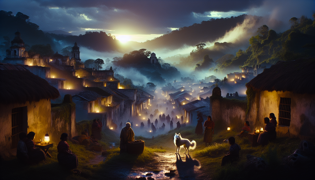
A Harrowing Encounter
In the shadow of the highlands, where the thin veil between the mortal realm and the supernatural wore thin, Diego’s journey took a perilous turn. Thick clouds of misgiving gathered on the horizon of his life, and the once-clear line between myth and reality blurred into uncertainty. One fateful evening, following a series of inexplicable misfortunes in the village, Diego’s path led him to a remote stretch of dense forest known to harbor stories of ancient wrath. The atmosphere was heavy with foreboding, as the twilight sky deepened into murky purples and smoky grays. The almost tangible silence of nature was interrupted only by the rustle of leaves and the distant cry of nocturnal birds. Diego’s heart pounded as he stepped cautiously into the undergrowth, aware that he was venturing not just into the physical wilderness but into a realm of inner darkness.
It was in this forest of secrets that his eyes met the gaze of the dreaded dark form of El Cadejo. Emerging from a corridor of ancient, gnarled trees, the dark canine appeared as a silhouette of pure malevolence. Its form was formidable and inexplicably shifting, as if crafted by shadows and despair. The creature’s eyes flashed with a chilling light, igniting a sensation of dread in Diego that was both physical and metaphysical. Every instinct urged him to flee, yet he found himself rooted to the spot. In that suspended moment, the old stories echoed in his mind—tales of souls ensnared by the ominous presence of the blackened spirit.
The air vibrated with an eerie tension as Diego felt the spirit’s intent to draw him into its realm of sorrow. It circled silently, an embodiment of darkness that threatened to engulf hope. Each careful step forward was a battle against the paralyzing grip of fear, and the environment itself seemed to conspire to magnify his inner turmoil. Twisted roots and scattered leaves bore witness to the timeless struggle between despair and the flicker of redemption that lay dormant within him. The forest, typically alive with the whispers of rustling canopies, became an arena of confrontation where every sound was amplified—his own breath, the distant snap of a twig, and the palpable thunder of his heart.
In the midst of this harrowing encounter, a confrontation of cosmic proportions unfurled. The dark form exuded an overwhelming aura of menace, its every movement a manifestation of the darker recesses of human emotion: regret, anger, and the all-consuming fear of the unknown. Diego’s inner conflict ignited, reflecting a struggle that was as ancient as time itself—a battle between succumbence to the haunting void and the courage to reclaim one’s light. In that heart-stopping instant, the forest bore silent witness to a man teetering on the edge of transformation, where the forces of both creation and destruction danced in a dangerous equilibrium. The spectral darkness challenged him, daring him to understand that to retreat was to forfeit the possibility of renewal.
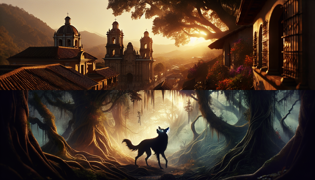
A Dusk of Redemption
The struggle with the dark spirit reached its zenith on a night when the heavens wept gentle rain and the earth shimmered with the reflections of a troubled soul. Diego’s inner turmoil culminated in a cathartic confrontation that transformed his understanding of both the legend and himself. In the clearing beyond the forest, where remnants of a long-forgotten colonial chapel stood encased in nature’s embrace, the duel between the dual forms of El Cadejo came to life. The air was charged with an alchemical mix of hope and despair, as if the clearing were a sacred crossroads in the spiritual realm. Here, nature itself bore witness—a gentle breeze rustling through ancient cypresses, droplets of rain catching the pale light and scattering it into a myriad of tiny rainbows.
As Diego stood in this mystical intersection, the ominous presence of the dark canine encircled him, a tangible force of raw, unbridled emotion. Yet, close by, the luminous white form manifested again—an emblem of guardian love and gentle redemption. In a moment heavy with symbolism, the two spirits circled each other, embodying the eternal duality: the darkness that tempts destruction and the light that offers solace. Their silent duel sent ripples through the night, each movement a dialogue of attrition and grace. Diego, caught between these opposing forces, sensed that the resolution lay not in defeating one half but in reconciling both. In that charged, bittersweet moment, he recognized that the dark and the white were not polar opposites to be vanquished, but complementary parts of a whole. They represented the fragmented pieces of his own soul—the fears he harbored and the hope he nurtured.
Binding his scattered thoughts into a single surge of resolve, Diego stepped forward. He embraced the darkness as a necessary facet of his existence and welcomed the healing radiance of the light. His voice, trembling yet determined, addressed the spirits as one: a plea for inner balance and acceptance. The clearing, illuminated by the interplay of shimmering droplets and soft moonlight, transformed into a sanctuary where bygone pain was met with compassion. Slowly, as if moved by the sincerity of his plea, the dark and white forms began to merge. Their edges softened, swirling together into a spectral dance. In that moment, Diego felt an indescribable warmth, a final surge of catharsis that washed away the lingering bitterness of his past. The duel faded, leaving behind a quiet, radiant peace that resonated deeply within him.
In the aftermath, the remnants of the two spirits dissolved into the night air. Yet, the essence of what had transpired lingered in every dewdrop and every ray of nascent moonlight—a silent testament that true transformation arises not from eradicating the darkness, but by illuminating it with the light of compassion and courage. With the first hints of an approaching dawn, the clearing seemed to breathe a new promise of hope and unity.
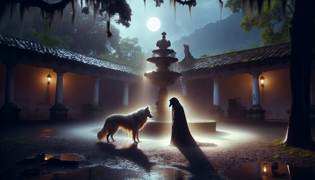
Conclusion
In the gentle glow of a new dawn, the village began to stir, subtly transformed by the age-old tale that had unfolded in its midst. Diego, now forever changed by his clandestine journey into the realms of myth and inner conflict, walked the familiar streets with a renewed sense of purpose. His eyes, once clouded by uncertainty, shone with a quiet determination and empathy that bridged the old and the new. He understood now that the legend of El Cadejo was more than a cautionary tale—it was a mirror reflecting the eternal human struggle to balance despair with hope, to welcome both the shadows and the light within. The dark form of the spirit, once feared as a harbinger of doom, had become a necessary counterpoint to the luminous guardian, each a vital part of a sacred balance that enriched the fabric of life.
As days turned into weeks, Diego shared his experiences with friends and elders alike. His recounting of that rain-kissed clearing and the spectral reconciliation resonated deeply with an entire community long burdened by unspoken fears. Stories, once confined to whispered lore at twilight, bloomed anew as symbols of resilience and unity. Through art, song, and renewed tradition, the villagers embraced the duality within themselves. The once daunting shadow now served as a reminder that within every heart lay the capacity for both struggle and redemption.
In the quiet cadence of everyday life, as sunlight filtered through the majestic trees near the central plaza, Diego’s journey became a timeless lesson. The sacred dance of light and darkness was not a battlefield to be conquered but a tapestry to be honored. The legend of El Cadejo lived on—an eternal parable that celebrated the potential for transformation when one dares to acknowledge every fragment of the soul, be it dark or bright. And so, with the rising sun casting golden hues over the village, hope rekindled in each heart, affirming that redemption is found not in the absence of fear, but in the courageous embrace of every part of oneself.

















